NOPEC
Well-known member
Well, it has only been about a hundred and seventy five years since Captain Sir John Franklin and his compliment of some 128 members of the Royal Navy vanished. Someone should really finally find him!!
High in the Canadian Arctic during the maniacal search for the elusive North West Passage from the North Atlantic to the rich trading paradise in the orient during the late 18th and early 19th century, many explorers and crews lost their way and ultimately, their lives. However, none seem to have captured the imagination of the world as has the case of Captain Sir John Franklin and the huge and continuing mystery of what actually happened to him and his crew in the mid 1800s.
Relatively few snippets of information has been gathered through a variety sources over the years and centuries. What is know is that Franklin's two ships, the Terror and the Erebus, ended up being icebound near the NW corner of King William Island close to 70 deg. N and 99 deg. W starting during the winter of 1846. Decades later, as a result of the discovery of a very short message left in a brass tube in a rock cairn on the NW shore of King William Island, it was learned that Franklin had died in June of 1847 while his vessels were still locked in the sea ice. These vessels were equipped with three years of rations so it is believed that the crew would have still been in relatively good condition and would have still had the energy to afford their deceased captain a land burial fitting his naval rank. Theoretically, they could have gotten to shore in June, either by crossing the ice on foot or dragging one of the lifeboats to the shore and then travelling up one of the numerous rivers that flow from inland of King William Island to the Arctic Ocean.
The subsequent race to find out what happened to the Franklin's expedition is pretty much just as interesting as the original mystery. First, there were considerable rewards offered up for the final answers by both the British Government and Franklin's widow, Lady Jane Franklin. The location of the actual Northwest Passage had pretty much been figured out and there were expectational motivations, both monetarily in the form of huge rewards for being the first to complete it and of course, the individual and national bragging rights which was on many levels, a way bigger deal, especially in those days. The stories and books that came out of the search are peppered with copious qualities of speculation, mistruths and selective and self-serving translation and interpretation of Inuit oral history. Theory's and opinions abounded on cannibalism (several of the recovered human long bones showed evidence of "cutmarks" but were never examined by credible forensic experts) as did theories on fatal lead poisoning caused by poor quality in the new "tin can" technology, speculated to have been caused by poor manufacturing techniques by British firms that were ripping off the government, and on and on.
However, among the journals and subsequent books, there was some really credible accounts, such as those written by arctic explorers Scotsman Dr. John Rae and Irishman Francis Mclintock.
What is known is that several artifacts such as naval uniform buttons, crested cutlery and dishes, etc., have been recovered from Inuit traders over the years and some of these have been positively identified as having originating from the Franklin expedition. As well, around 30 sets of human remains have either actually been located or reported on by Inuit travelers in the area of the west coast of the island as well as, on on the mainland (immediately adjacent to and south of King William Island) across part of the ocean know as Simpson Strait. Some of these remains were located in the aptly named "Two Grave Bay" and "Starvation Point".
And, two very important discoveries were made fairly recently. The sunken remains of both vessels were located in the waters SW of King William Island. The most credible theory is that both ships remained locked in the sea ice at the north end of King William Island for at least a year after the death of Franklin and at some time, the surviving crews decided to try and effect their own self rescue, by walking 100s of Kilometers south down the west side of the island, crossing to the mainland and then to outlying Hudson's Bay posts. Of course, they never made it. The seasonal pack ice in the arctic moves around considerably due to winds and current and it a reasonable theory that the ice locked, heavily damaged (due to being crushed by the ice) ships could have been blown several hundred kilometers before being released from the ice and sinking.
How does all of this relate to ExPo?
Well, I happen to be really close friends with a couple of the most enthusiastic Franklin historians who still believe they can find both the remains of Franklin in a hidden tomb and artifacts in the tomb which will unlock many unanswered questions. My partner and I were lucky enough to be invited to assist them this summer (we just got back). We flew to Gjoa Haven, the only settlement on King William Island and then spent two and a half weeks on ATVs (AKA "quadding" in Canada..) some 800 kilometers over much of the island, following some new leads that have been in the works.
I'll write "Part two" about the trip, the land, the search, the "quads", etc, and post it soon.
Artist Impression of the ice bound HMS Terror and Captain Sir John Franklin (in better times...)
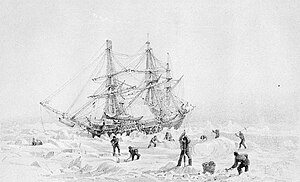
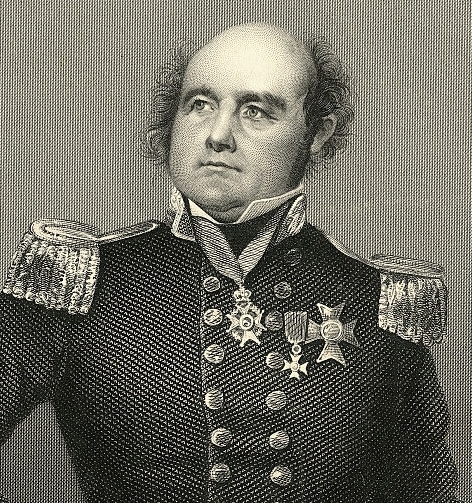
Leaving Gjoa Haven, Nunavut
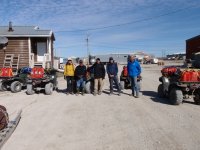
Constant load checking and tightening ratchets
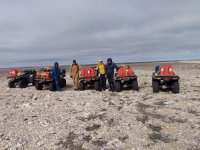
Prepping for a river crossing
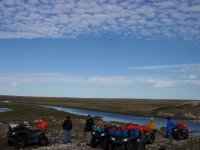
The rivers are not usually too deep but generally have a shale (good) and/or mud bottom (bad..). The sweet spot is not always obvious so lots of scouting prior to commitment
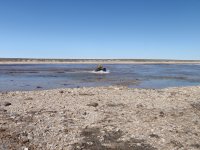
Constant search for artifacts

High in the Canadian Arctic during the maniacal search for the elusive North West Passage from the North Atlantic to the rich trading paradise in the orient during the late 18th and early 19th century, many explorers and crews lost their way and ultimately, their lives. However, none seem to have captured the imagination of the world as has the case of Captain Sir John Franklin and the huge and continuing mystery of what actually happened to him and his crew in the mid 1800s.
Relatively few snippets of information has been gathered through a variety sources over the years and centuries. What is know is that Franklin's two ships, the Terror and the Erebus, ended up being icebound near the NW corner of King William Island close to 70 deg. N and 99 deg. W starting during the winter of 1846. Decades later, as a result of the discovery of a very short message left in a brass tube in a rock cairn on the NW shore of King William Island, it was learned that Franklin had died in June of 1847 while his vessels were still locked in the sea ice. These vessels were equipped with three years of rations so it is believed that the crew would have still been in relatively good condition and would have still had the energy to afford their deceased captain a land burial fitting his naval rank. Theoretically, they could have gotten to shore in June, either by crossing the ice on foot or dragging one of the lifeboats to the shore and then travelling up one of the numerous rivers that flow from inland of King William Island to the Arctic Ocean.
The subsequent race to find out what happened to the Franklin's expedition is pretty much just as interesting as the original mystery. First, there were considerable rewards offered up for the final answers by both the British Government and Franklin's widow, Lady Jane Franklin. The location of the actual Northwest Passage had pretty much been figured out and there were expectational motivations, both monetarily in the form of huge rewards for being the first to complete it and of course, the individual and national bragging rights which was on many levels, a way bigger deal, especially in those days. The stories and books that came out of the search are peppered with copious qualities of speculation, mistruths and selective and self-serving translation and interpretation of Inuit oral history. Theory's and opinions abounded on cannibalism (several of the recovered human long bones showed evidence of "cutmarks" but were never examined by credible forensic experts) as did theories on fatal lead poisoning caused by poor quality in the new "tin can" technology, speculated to have been caused by poor manufacturing techniques by British firms that were ripping off the government, and on and on.
However, among the journals and subsequent books, there was some really credible accounts, such as those written by arctic explorers Scotsman Dr. John Rae and Irishman Francis Mclintock.
What is known is that several artifacts such as naval uniform buttons, crested cutlery and dishes, etc., have been recovered from Inuit traders over the years and some of these have been positively identified as having originating from the Franklin expedition. As well, around 30 sets of human remains have either actually been located or reported on by Inuit travelers in the area of the west coast of the island as well as, on on the mainland (immediately adjacent to and south of King William Island) across part of the ocean know as Simpson Strait. Some of these remains were located in the aptly named "Two Grave Bay" and "Starvation Point".
And, two very important discoveries were made fairly recently. The sunken remains of both vessels were located in the waters SW of King William Island. The most credible theory is that both ships remained locked in the sea ice at the north end of King William Island for at least a year after the death of Franklin and at some time, the surviving crews decided to try and effect their own self rescue, by walking 100s of Kilometers south down the west side of the island, crossing to the mainland and then to outlying Hudson's Bay posts. Of course, they never made it. The seasonal pack ice in the arctic moves around considerably due to winds and current and it a reasonable theory that the ice locked, heavily damaged (due to being crushed by the ice) ships could have been blown several hundred kilometers before being released from the ice and sinking.
How does all of this relate to ExPo?
Well, I happen to be really close friends with a couple of the most enthusiastic Franklin historians who still believe they can find both the remains of Franklin in a hidden tomb and artifacts in the tomb which will unlock many unanswered questions. My partner and I were lucky enough to be invited to assist them this summer (we just got back). We flew to Gjoa Haven, the only settlement on King William Island and then spent two and a half weeks on ATVs (AKA "quadding" in Canada..) some 800 kilometers over much of the island, following some new leads that have been in the works.
I'll write "Part two" about the trip, the land, the search, the "quads", etc, and post it soon.
Artist Impression of the ice bound HMS Terror and Captain Sir John Franklin (in better times...)


Leaving Gjoa Haven, Nunavut

Constant load checking and tightening ratchets

Prepping for a river crossing

The rivers are not usually too deep but generally have a shale (good) and/or mud bottom (bad..). The sweet spot is not always obvious so lots of scouting prior to commitment

Constant search for artifacts

